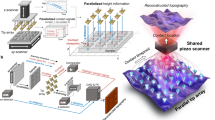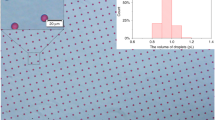Abstract
Atomic force microscopy (AFM) is a useful tool for studying the morphology or the nanomechanical and adhesive properties of live microorganisms under physiological conditions. However, to perform AFM imaging, living cells must be immobilized firmly enough to withstand the lateral forces exerted by the scanning tip, but without denaturing them. This protocol describes how to immobilize living cells, ranging from spores of bacteria to yeast cells, into polydimethylsiloxane (PDMS) stamps, with no chemical or physical denaturation. This protocol generates arrays of living cells, allowing statistically relevant measurements to be obtained from AFM measurements, which can increase the relevance of results. The first step of the protocol is to generate a microstructured silicon master, from which many microstructured PDMS stamps can be replicated. Living cells are finally assembled into the microstructures of these PDMS stamps using a convective and capillary assembly. The complete procedure can be performed in 1 week, although the first step is done only once, and thus repeats can be completed within 1 d.
This is a preview of subscription content, access via your institution
Access options
Subscribe to this journal
Receive 12 print issues and online access
$259.00 per year
only $21.58 per issue
Buy this article
- Purchase on Springer Link
- Instant access to full article PDF
Prices may be subject to local taxes which are calculated during checkout




Similar content being viewed by others
References
Binnig, G., Quate, C.F. & Gerber, C. Atomic force microscope. Phys. Rev. Lett. 56, 930–934 (1986).
Gerber, C. & Lang, H.P. How the doors to the nanoworld were opened. Nat. Nanotechnol. 1, 3–5 (2006).
Louise Meyer, R. et al. Immobilisation of living bacteria for AFM imaging under physiological conditions. Ultramicroscopy 110, 1349–1357 (2010).
Doktycz, M.J. et al. AFM imaging of bacteria in liquid media immobilized on gelatin coated mica surfaces. Ultramicroscopy 97, 209–216 (2003).
Kasas, S. & Ikai, A. A method for anchoring round shaped cells for atomic force microscope imaging. Biophys. J. 68, 1678–1680 (1995).
Kailas, L. et al. Immobilizing live bacteria for AFM imaging of cellular processes. Ultramicroscopy 109, 775–780 (2009).
Francius, G., Domenech, O., Mingeot-Leclercq, M.P. & Dufrêne, Y.F. Direct observation of Staphylococcus aureus cell wall digestion by lysostaphin. J. Bacteriol. 190, 7904–7909 (2008).
Alsteens, D. et al. Structure, cell wall elasticity and polysaccharide properties of living yeasts cells, as probed by AFM. Nanotechnology 19, 384005 (2008).
Dague, E., Alsteens, D., Latgé, J.-P. & Dufrêne, Y.F. High-resolution cell surface dynamics of germinating Aspergillus fumigatus conidia. Biophys. J. 94, 656–660 (2008).
Gilbert, Y. et al. Single-molecule force spectroscopy and imaging of the vancomycin/D-Ala-D-Ala interaction. Nano Lett. 7, 796–801 (2007).
Dague, E. et al. Assembly of live micro-organisms on microstructured PDMS stamps by convective/capillary deposition for AFM bio-experiments. Nanotechnology 22, 395102 (2011).
Francois, J.M. et al. Use of atomic force microscopy (AFM) to explore cell wall properties and response to stress in the yeast Saccharomyces cerevisiae. Curr. Genet. 59, 187–196 (2013).
Pillet, F., Chopinet, L., Formosa, C. & Dague, É. Atomic force microscopy and pharmacology: from microbiology to cancerology. Biochim. Biophys. Acta 1840, 1028–1050 (2014).
Chopinet, L., Formosa, C., Rols, M.P., Duval, R.E. & Dague, E. Imaging living cells surface and quantifying its properties at high resolution using AFM in QITM mode. Micron 48, 26–33 (2013).
Formosa, C. et al. Nanoscale effects of Caspofungin against two yeast species, Saccharomyces cerevisiae and Candida albicans. Antimicrob. Agents Chemother. 57, 3498–3506 (2013).
Pillet, F. et al. Uncovering by atomic force microscopy of an original circular structure at the yeast cell surface in response to heat shock. BMC Biol. 12, 6 (2014).
Beauvais, A. et al. Deletion of the α-(1,3)-glucan synthase genes induces a restructuring of the conidial cell wall responsible for the avirulence of Aspergillus fumigatus. PLoS Pathog. 9, e1003716 (2013).
Dufrêne, Y.F., Martínez-Martín, D., Medalsy, I., Alsteens, D. & Müller, D.J. Multiparametric imaging of biological systems by force-distance curve-based AFM. Nat. Methods 10, 847–854 (2013).
Dufrêne, Y.F. Atomic force microscopy and chemical force microscopy of microbial cells. Nat. Protoc. 3, 1132–1138 (2008).
Francius, G. et al. Stretching polysaccharides on live cells using single-molecule force spectroscopy. Nat. Protoc. 4, 939–946 (2009).
Beaussart, A. et al. Quantifying the forces guiding microbial cell adhesion using single-cell force spectroscopy. Nat. Protoc. 9, 1049–1055 (2014).
Roduit, C. et al. OpenFovea: open-source AFM data processing software. Nat. Methods 9, 774–775 (2012).
Cai, D.K., Neyer, A., Kuckuk, R. & Heise, H.M. Optical absorption in transparent PDMS materials applied for multimode waveguides fabrication. Opt. Mater. 30, 1157–1161 (2008).
Chabinyc, M.L. et al. An integrated fluorescence detection system in poly(dimethylsiloxane) for microfluidic applications. Anal. Chem. 73, 4491–4498 (2001).
Liu, S. & Wang, Y. Application of AFM in microbiology: a review. Scanning 32, 61–73 (2010).
JPK Instruments. QITM mode-quantitative imaging with the Nanowizard 3 AFM. http://usa.jpk.com/index.download.419baba450fa6c06a245970866047614.
Formosa, C. et al. Multiparametric imaging of adhesive nanodomains at the surface of Candida albicans by atomic force microscopy. Nanomed. Nanotechnol. Biol. Med. 10.1016/j.nano.2014.07.008 (4 August 2014).
Acknowledgements
We thank Techniques et Equipements Appliqués à la Microélectronique (TEAM) engineers and especially A. Laborde for their technical support in silicon master fabrication. We thank V. Beges for artwork on Figure 1. This work was supported by an Agence Nationale de la Recherche (ANR) young scientist program (AFMYST project ANR-11-JSV5-001-01 no. SD 30024331) to E.D. E.D. is a researcher at the Centre National de Recherche Scientifique. C.F. and M.S. are, respectively, supported by a grant from 'Direction Générale de l'Armement' and by funding from Lallemand.
Author information
Authors and Affiliations
Contributions
E.D. and L.R. developed the concept and designed the experiments; E.D., L.R., R.E.D. and C.F. conceived and designed the experiments and wrote the article. E.D., C.F., F.P. and M.S. made the experimental work and the data analysis work; C.F., F.P. and M.S. worked on the experimental protocol; and all authors discussed the results and commented on the manuscript.
Corresponding author
Ethics declarations
Competing interests
The authors declare no competing financial interests.
Supplementary information
Supplementary Data
Example CleWin file of a micropattern for the silicon master. (ZIP 320 kb)
Rights and permissions
About this article
Cite this article
Formosa, C., Pillet, F., Schiavone, M. et al. Generation of living cell arrays for atomic force microscopy studies. Nat Protoc 10, 199–204 (2015). https://doi.org/10.1038/nprot.2015.004
Published:
Issue Date:
DOI: https://doi.org/10.1038/nprot.2015.004
This article is cited by
-
Force spectroscopy of single cells using atomic force microscopy
Nature Reviews Methods Primers (2021)
-
Effect of trans(NO, OH)-[RuFT(Cl)(OH)NO](PF6) ruthenium nitrosyl complex on methicillin-resistant Staphylococcus epidermidis
Scientific Reports (2019)
-
Advances in atomic force microscopy for single-cell analysis
Nano Research (2019)
-
Atomic Force Microscopy: A Promising Tool for Deciphering the Pathogenic Mechanisms of Fungi in Cystic Fibrosis
Mycopathologia (2018)
-
Applications of Atomic Force Microscopy in Exploring Drug Actions in Lymphoma-Targeted Therapy at the Nanoscale
BioNanoScience (2016)
Comments
By submitting a comment you agree to abide by our Terms and Community Guidelines. If you find something abusive or that does not comply with our terms or guidelines please flag it as inappropriate.



